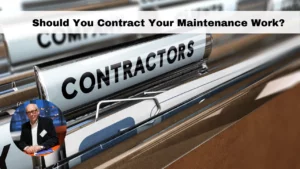There are many levels of outsourcing maintenance work. The most common include:
1. Outsourcing of the whole maintenance function. This is often done by forming a separate maintenance company. This company will provide reliability and/or services to the manufacturing organization.
2. Outsourcing of work done during scheduled shutdowns and outages. This is very common in the pulp and paper industry. It is not cost effective to not bring in extra resources during peak loads.
3. Outsourcing of special skills. Special skills that are not often used in your maintenance organization can be good to outsource, as it otherwise is difficult to keep up with new technology and maintain skills. A maintenance organization with fewer than 1,500 bearings in their vibration analyses program can be an example of where outsourcing of this work can be cost effective.
4. Outsourcing of equipment or a system function. Some companies offer to sell a guaranteed function at a fixed cost including operations and maintenance. Guarantee includes reliability performance. An example is pumps, compressors and mobile equipment. The difficulty here is that many problems are induced by abusive operations practices. This can make it difficult and time consuming to decide who will pay for these incidents.
5. Outsourcing of spare parts store. You could sell your store and outsource this service to a company specializing in this area.
There are more levels but these are the most common I have experienced
Why outsource at all?
The reasons for outsourcing are many.
Suppliers of outsourcing services promise lower costs and better reliability, often in that order. In my opinion, a contract should be based on guaranteed reliability and lower costs.
Of course, there are many successful examples of outsourcing of maintenance and it can be a good choice for many organizations.
If you consider outsourcing, you should always ask yourself why a contractor could deliver lower costs and better reliability than you can with your own organization.
The provider will most probably argue that they can implement better reliability and maintenance processes. This might very well be true but they also must make a profit on top of that and you have to ask why you do not have the leadership in place to do that yourself.
There are many examples where outsourcing was done as an “Act of desperation”. Often unions and management have been in a gridlock, the final solution became outsourcing, and that has many times led to real change and improvements.
A contributing reason can be that if you outsource, the fixed cost you had before outsourcing, is now a variable cost even if it seldom varies much.
Outsource of maintenance
Often we only talk about outsourcing of maintenance without much emphasis on reliability incentives. Outsourcing contracts based on outsourcing of the whole maintenance function often focus too much on reducing the cost of maintenance instead of the results derived from improved maintenance performance.
The sales argument is often heavy on the cost savings you can achieve. The suppliers then have to set up better work management systems and most probably also provide lower total costs for labor and management.
In today’s shortage of skilled craftspeople this is a very difficult situation. A plant reported that their contractor had electricians staying an average of only 18 months, then they left to a better paying job. This caused many problems for both the plant and the contractor.
Outsourcing of reliability
Reliability is here measured as % Quality performance x % Time Performance x % Speed performance.
This is the most common way to measure reliability.
- Quality performance is the most important and is measured as the % of Saleable Quality product made divided by total paper made.
- Time performance, often called Availability, is often measured as % time making product divided by available hours over the same period of time. (During a year for a 7/24 operation that is 8760 hours or 8784 hours if it is during a leap year).
- Speed performance is a moving target and is set per product manufactured. It is measured as % speed divided by set speed performance for that product.
If an outsourcing contract is based on reliability the whole scenario will change. In this scenario, the focus will be on delivering results with a focus on reliability improvements followed by lower costs about two years later.
When entering into the first year or two of a reliability based outsourcing contract, maintenance costs are very likely to go up before they start declining in the second or third year. Reliability will improve before that.
Cost focus
If an outsourcing contract is based on maintenance cost alone, without an incentive to reduce cost, it might lead the provider to more of an incentive to sell service in the form of hours instead of delivering results.
If the contract is based too much on reducing costs, it better be no less than five years long. Anybody can reduce maintenance costs during a period of two, max. three years, after that costs will go up because the maintenance work you postponed to save money start catching up with you.
This is a story repeated in many cost focused maintenance departments and it does not matter whether your maintenance department is outsourced or not.
Reliability focus
It is a well-proven fact that improved reliability will drive down maintenance and other costs. It is also common sense: If equipment is running reliable, we make product and it costs less to maintain because of fewer problems.
Of course, there is a limit to how much you can pay to increase reliability but most actions you need to take to improve reliability is to do better with what you already have.
Most of these actions include better basic inspections and use of cost effective condition monitoring tools, planning of work, scheduling of work, execution of planned and scheduled work, recording of what was done and triggers to do Root Cause Problem Elimination.
All this can be done with a very reasonable cost with good leadership, training and coaching.
Balance
As a first step, the parties have to agree on a balance between reliability and cost incentives as a foundation for the contract. To me it is clear that reliability is the most important factor. This first step will govern the details in the contract.
Common Obstacles
A very common obstacle is the difficulty to build a true partnership between Operations-Stores-Maintenance and Engineering.
With very few exceptions, the contractor will be looked upon as a service provider and not a true partner in reliable manufacturing. I have worked with many outsourced maintenance departments and this comes up as the most critical obstacle to overcome.
Typically, operations demand work based on emotional priorities. This is expensive because work is done with higher priority than necessary.
The results are that work schedules are changed and the crews’ productivity goes down. A contractor should consider charging a much higher fee for work done based on an emotional priority.
It can also be difficult to get modifications to improve maintainability and reliability through the engineering department completed. Stores need to support the maintenance function with staging and delivery of parts etc. All these phenomenon are very common also in insourced maintenance departments, but they are in a better position to do something about them.
One way of overcoming these obstacles is to outsource both operations and maintenance including stores and engineering.
This is common in companies where manufacturing is looked upon as a non-core business. Examples include manufacturing of refrigerators, TVs, Computers etc. where one plant often manufactures many brand names.
One sales argument for outsourcing of maintenance is that maintenance is not a core business.
To some extent I agree when it comes to carpentry work, painting, yards etc. but I do believe that reliability functions such as management of work, lubrication, condition monitoring, root cause problem elimination and continuous improvement all are core businesses in a manufacturing organization.
Conclusion : There are only three ways you can reduce maintenance costs:
1. Cut the budget. This leads to short-term savings and long-term losses. As a maintenance manager you can only defer maintenance work and if the work is valid to do, it will catch up with you as a more expensive job later.
2. Execute maintenance prevention well. This includes buying equipment based on Life Cycle Cost (LCC) principles and to execute the following basics of reliability and maintenance with excellence: Lubrication, Filtration, Cleaning, Alignment, Balancing and Operating practices.
3. Execute remaining maintenance with excellence. This requires that processes have to be implemented for: Basic Inspections and Condition Monitoring, Priorities, Planning of work*, Scheduling of work, Execution of work, Recording of work done and Root cause Problem Elimination.
* Supported by an up to date bill of material for all equipment.
These are guiding principles for good reliability and maintenance practices. They are the same as they been since the early sixties.
The only thing that has changed is better and more affordable technologies and computer systems. It does not matter if you decide to outsource or insource your reliability and maintenance organization, these principles must be implemented and executed well. They will drive up reliability and drive down cost in a sustainable way.
You always have to ask yourself if outsourcing of reliability and maintenance can accomplish this faster and better than your own organization.
If you do not have, or can’t get, the leadership in place in your own organization you should consider outsourcing.





